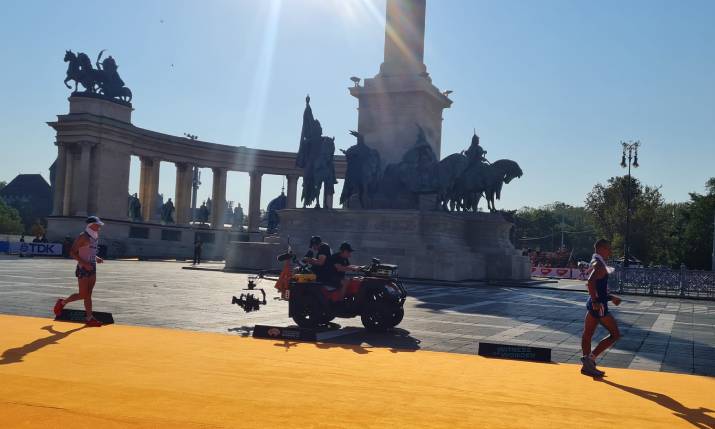Live from Budapest: Bringing a reality TV edge to the World Athletics Championships 2023 with a 1km long wirecam, q Room cameras and more
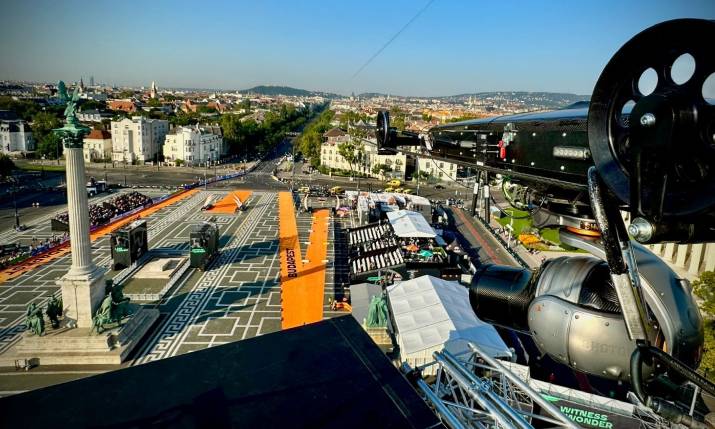
With the structure designed and created by West End Rigging, and the camera set up provided and operated on site by Luna Remote Systems, the 985m-long wirecam for the World Athletics Championships race walks and marathon that runs along Andrássy Avenue to Hero’s Square is a feat to be marvelled at
Storytelling is a key focus of the World Athletic Championships 2023, and to that end, World Athletic Productions – a joint venture between World Athletics and ITN – has rolled out a number of innovations that helped bring more dramatic pictures and more behind-the-scenes drama to rights holding broadcasters.
World Athletic Productions decided against using any helicopters for this championships for sustainability reasons. Instead, to get those aerial shots it used a drone, plus wirecams inside the stadium including one capturing the horizontal jumps to track the athletes’ lateral movement, and in a world first, a one kilometre-long wirecam running along Andrássy Avenue to Hero’s Square for the race walks and marathon.
In addition, small cameras were installed on buggies transporting athletes from their warm up areas to the stadium, and for an added sense of jeopardy, the new q Room and its cameras captured the drama of athletes awaiting their results.
Speaking from the National Athletics Centre stadium in Budapest overlooking the Danube, Mark Fulton, executive producer for World Athletics Productions, comments: “I think this World Championships, I think we’ve really excelled. I think some of the close-ups that you’ve seen of the athletes, some of the reactions that you’ve seen of athletes, I don’t think I’ve seen some of the images [ever before] like we’re seeing at the moment. I think everybody’s worked really, really hard and I think the storytelling and the narratives are just building themselves.”
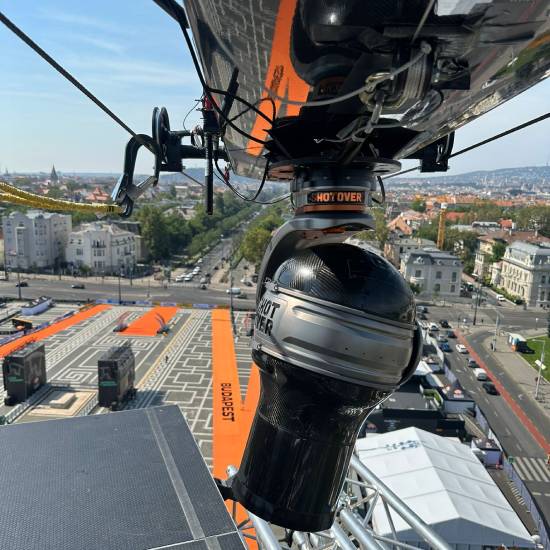
The 1km-long World Athletic Productions’ wirecam’s camera head used is a Sony P50 with a Canon CJ45 lens which can go remarkably tight on shots. The gimbal is a Shotover M1 with six-access stabilisation which makes it solid as it zips along. Altogether just the camera, lens and stabilised head come in at a price of around Euro 400,000
Marvellous wirecam
With the structure designed and created by West End Rigging, and the camera set up provided and operated on site by Luna Remote Systems, the 985m-long wirecam that runs along Andrássy Avenue to Hero’s Square is a feat to be marvelled at.
The wirecam towers are 40m high with the cables attached at the 34m point on the tower ends. The lowest part of the wire is 21m above ground level, which drops in the centre due to the payload of the entire dolly and head which comes to 80kg.
Additionally, the lines attached to each tower provide a massive 1.2 tonnes of pressure on each of the two lines, creating 2.4 tonnes of pressure pulling each tower inwards. To counter this, each tower has 60 tonnes of ballast holding it back.
For stability, the dolly speed is restricted to 10m per second, which is 22 miles per hour or 36km per hour for this set up, however the system has a maximum tested speed of 30m per second which is equal to 67 miles per hour, or 108km per hour but that requires a winch to be deployed at each end, rather than the single winch being used in this case.
The camera head used is a Sony P50 with a Canon CJ45 lens which can go remarkably tight on shots. The gimbal is a Shotover M1 with six-access stabilisation which makes it solid as it zips along. Altogether just the camera, lens and stabilised head come in at a price of around Euro 400,000.
Fulton comments on what the 1km wirecam enables the team to do editorially: “If you think about a 10-kilometre course, if you have a 1km wirecam, 2km of that course is covered. And then when you look at the city itself, the city is so beautiful, there’s no point in putting helicopters; you’d get a nice skyline, but you want to be down at street level and seeing the beauty of the city and the athletes running through the streets.”
He adds on the 1km wirecam: “It’s solid as a rock. It’s got a stabilised lens. I think when we watched the race walks the other day when they used it, you just get some amazing images of looking down over the top of the athletes as they come around the carpet and the shadows that you get of it is just [beautiful]. I think it’s one of the big successes of these championships.”
On the 1km wirecam, Jenny King, head of technical production at ITN, says: “The main areas we’ve been looking at are the wirecam set ups. Just focusing on the marathon race walk, which is a beautiful area of Budapest at Hero Square, we’ve got a 1km wirecam, which runs from the top of Hero Square all the way down, which has covered the men’s and women’s 20 kilometre walk which we’ve already broadcast. Then it will be used in the marathon itself and the 35K.
“It is elements like that which are really enhancing the coverage, I think,” continues King. “As the athletes come round Hero Square, we’ve got a specially designed camera on a gimbal which sits on the back of a buggy to get some really nice angles of the athletes coming around. You can really see the architecture of Hero Square, so that’s been really nice.”
Freelancer Graham Holmes is responsible for the electric bikes and also put together the buggy in Hero’s Square. He took an electric buggy and added a Steadicam arm with a camera on the back of it for dramatic shots that shoot up through the athletes into the backdrop of the impressive architecture of Hero’s Square.
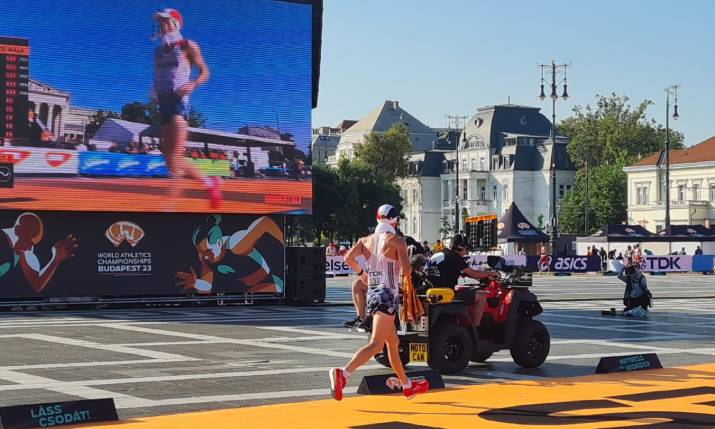
The new electric buggy cam in Hero’s Square gave amazing footage of both the athletes and the architecture in the 35km race walk at the World Athletic Championships 2023
Increased storytelling
On the new, very small cameras in the buggies that bring athletes from the warm up area to the stadium, Fulton says: “The athletes have suddenly realised that they’re there after three or four days now, and they’re all looking at it and they’re playing it up, you get all sorts of things, and it gives you an idea of what an athlete is like. You’ll get the athletes that sit and do nothing. You get the athletes that’ll sit and put makeup on, you get athletes that will sit and that’ll high five people as they’re going past them. You get ones that will talk to each other.
“It gives you a real insight into what their mindset is and how each athlete is very, very different, and I think that is a really key part to this. But also as well, I think some of it is – and I’ve said this about the q Room – is that it’s our take on reality television, a very sly take on reality television.”
The main warm up and training venue for the championships is located right next to the National Athletics Centre. There are four separate areas including a 400m track,
King adds on the athlete transport buggy cams: “I think [they’re] part of the athlete storytelling, so it’s getting them from the warm up track over into the stadium. We’ve put in buggy cams so that you can see the athletes coming across the bridge in the buggies, which again gives a different perspective to their journey into the stadium, which has been quite fun to watch.”
Fulton continues: “Everybody’s obsessed by people’s reactions and how people are in certain situations, and it’s incredibly stressful when they’re in the q Room,” Fulton continues.
The q Room is a new addition to the World Athletics Championships, adding an opportunity for increased storytelling. Athletes that do not automatically qualify for the next round of their event are transitioned to the q Room where they wait for the outcome of remaining races to see where they are positioned, with all the tension and emotion captured on camera for rights holding broadcasters.
“You’d never think, but the relief on the face of Sha’Carri Richardson the other day,” continues Fulton. “She went on and won the hundred metres, but she was terrified in that q Room that she wasn’t going to get through. I mean, she got through easily in the end, but she was very, very nervous when it came to that last heat, that last semi-final.”
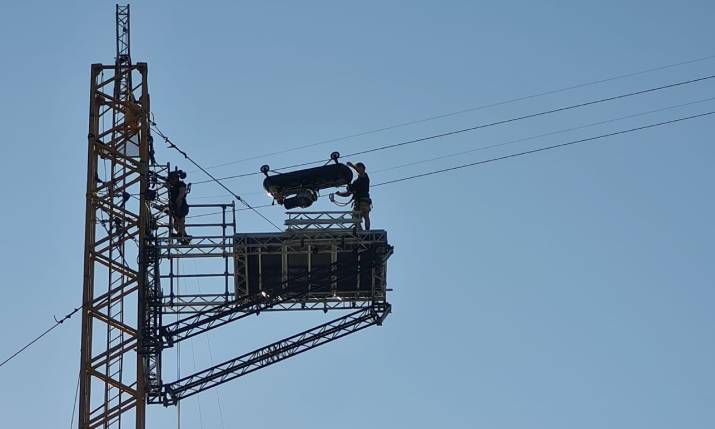
High in the sky, engineers look after the 1km-long railcam above Budapest’s Hero’s Square at the World Athletic Championships
Stadium coverage
On the drone, King comments: “We’ve got a drone which is in action and we’ve used that in the marathon, and also when it’s not in use there, we bring it over to the stadium. We managed to do some nice filming before the championship started where we could get a view of the athlete’s journey from when they arrived at the warm up track, and then their journey into the stadium, into the cool room, and then out into the main stadium itself. That’s been really good.”
In the stadium two Dactylcam (point to point) wirecam systems were used with a Shotover G1 head, Sony camera and Cannon lens (both with 24:1 lens). One wirecam was used on back straight for horizontal jump run ups, and the other was used on the home straight to cover the long jump run up. Also one Falcon 250 with a Shotover G1 head, Sony camera and Cannon lens (22:1) was used, suspended in line with lanes four and five, which was used for the start of races and tracking down the back straight. It was also used for the pole vault final and horizontal jumps.
King comments: “Then within the stadium itself, we’ve got a few wirecams, [including] quite a long one running right across the top of the stadium and we’ve got one along the back straight and the home straight. Then we’ve also got rail cams, which are, again, one on the home straight and one on the back straight.
“Again, I think normally you would only probably have the rail cams, but just putting in the wirecams has given that extra depth of the coverage, you can get different angles,” she notes.
Hero shots
Outside of the stadium, the 20km and 35km race walks were produced with 18 cameras, the electric buggy, and a bodycam was used on the referee to get his perspective as he penalised athletes.
Meanwhile the marathon used 21 cameras, plus three jibs, two super slomo cameras and one ultra slow mo, and five electric bikes including one for a commentator and one for Japanese broadcaster TBS. The electric buggy in Hero’s Square was also used.
To get all the content from the bikes back to the gallery, fibre points were used for the first time. Says Andy Reid, technical producer for World Athletic Productions marathon and race walks, speaking at Hero’s Square under one end of the looming wirecam towers: “Normally we use a plane in the sky to beam the bike pictures up on RF, which is quite expensive. What we’re doing is receiving [the live pictures] at 10 RF points around the city and then they’re coming back to us via fibre for the marathon, and for one or two cameras on the race walks.”
